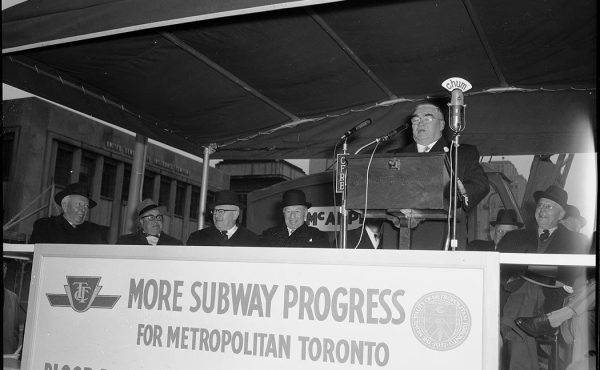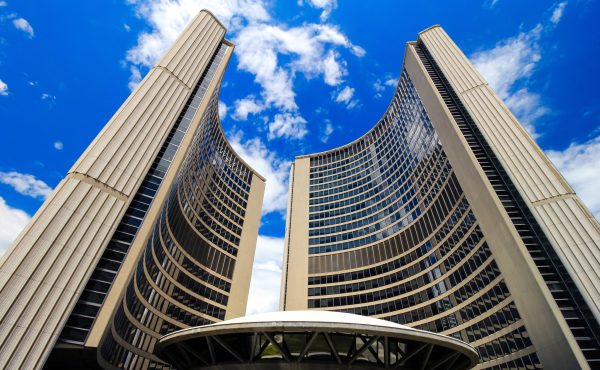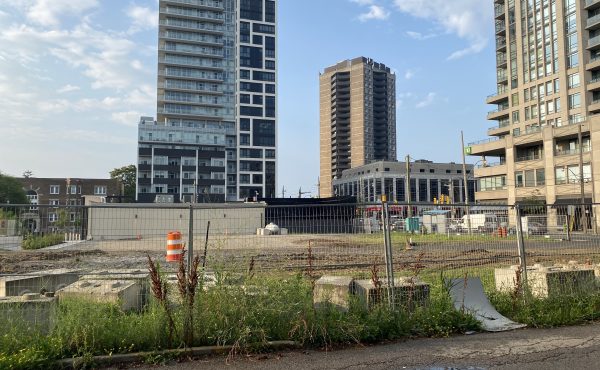

Another day, another subway platform.
Adding his voice to the chorus of calls for subway expansion, mayoral candidate Rocco Rossi yesterday unveiled his own program, this one to be funded using the dividend of his plan to sell off Toronto Hydro and retire the city’s $2.5 billion debt load.
Standing on the Kay Gardner bridge south of the Davisville Station, Rossi said yesterday that he plans to invest $4.5 billion over ten years, with funds drawn from the city’s operating budget. By paying off the accumulated debt, Rossi said the city would save about $450 million a year in interest payments.
The announcement brought a swift put-down from George Smitherman, who issued a release that said, “Torontonians now have the right to question Mr. Rossi’s competence to be mayor” because of “errors” and “holes” in the plan.
The annual savings, according to Rossi’s proposal (dubbed “Transit City Plus”), should pay for the construction of two kilometres of tunnel plus a station every year, with the TTC relying on a continuous tunneling approach to save start-up costs.
Rossi also said he’d delay the Downtown Relief Line in favour of completing the Sheppard subway and extending the Yonge line up into York Region.
Like Sarah Thomson, Rossi wants private sector involvement in these projects to bring costs down, but he rejected road tolls as a way of raising revenue. Also like Thomson, Rossi’s numbers are unrealistically optimistic and fail to account for a range of associated budget pressures.
His plan assumes subway construction costs of $225 million per kilometer, which is almost a third less than what’s being spent currently on the Spadina extension into Vaughan. Nor does it not include the purchase of additional subway cars, the little matter of the TTC’s $400 million a year operating deficit, and the fallout from mounting overcrowding on a Yonge line that will be expected to serve transit-starved 905ers. Finally, he hasn’t factored in the loss of the Hydro dividend payment, which adds about $25 to $50 million a year to the city’s revenue stream.
Smitherman further pointed out that the Hydro sale would trigger a 33% transfer tax.
Rossi’s pitch also presumes the city’s interest payments will remain negligible after he uses the Hydro proceeds to retire the debt. But according to council’s long-term capital plan, the city will spend about $16 billion over the next decade on a broad range of infrastructure improvements (road/bridge repairs, transit maintenance, water mains, etc.), adding $4.7 billion in new net debt.
That’s twice as much debt as we have today, meaning the city will again be faced with a very substantial annual interest outlay, except in a decade, we’ll have no big asset to sell off in order to make that line item disappear.
And thus we arrive at the wing-and-a-prayer aspect of Transit City Plus.
Rossi, like Mel Lastman did over a decade ago, is talking about using the subway expansion to drive high-density development activity along the new lines. Eventually, the density will materialize, but not in the time frame Rossi envisions.
Then there’s the Metrolinx psychodrama. The agency is expected to release a modified version of its Big Move plan on May 19 in response to the province’s move to delay the funding of Transit City and Viva.
Rossi yesterday would not rule out the possibility of asking Metrolinx to take over the subways whole cloth. “That’s part of the discussion we need to have,” he said, adding. “While it’s on the table, [the transfer] is not a foregone conclusion.”
He also hinted that he’d be open to asking Metrolinx to re-allocate part of the $8 billion Transit City funding to the subways he’s proposing. His gambit — and you’ve heard this one before — is that if Toronto shows its got the intestinal fortitude to finance subway construction on its own dime, our provincial overlords will be sufficiently impressed that they’ll give us a top-up if we ask nicely.
But can Torontonians take that one to the bank? Hardly. Just look at what happened with the triple-promised LRT funding.
Give Rossi this much: he’s been willing to cough up a somewhat plausible financing scenario, unlike Thomson or Rob Ford. But for someone who’s fashioned himself as a number cruncher, his arithmetic still leaves much to be desired.
photo by Kevin Steele




17 comments
Rossi completely lost me right here: «Rossi also said he’d delay the Downtown Relief Line in favour of completing the Sheppard subway and extending the Yonge line up into York Region.»
We need the DRL to increase core capacity before we entertain the idea of building north. It’s bad enough we’re stuck the the Vaughan extension (to nowhere), that money could be very useful building a DRL.
“Rossi also said he’d delay the Downtown Relief Line in favour of completing the Sheppard subway and extending the Yonge line up into York Region.”
In other words, he’d rather pander to his biggest potential constituency instead of build it where it’s most needed now.
While I support extending the Sheppard subway in both directions and turning it into the Bloor-Danforth line of the North (where busses feed into it), extending the subway much past Steeles is wasting money for people who Rossi shouldn’t be considering. They’re not part of Toronto. Not a dime should be spent by the city to extend the subway there unless somebody else pays 100% of it. Toronto taxpayers already subsidize them whenever they use the TTC.
The Vaughan extension (which I may add isn’t being delayed like Transit City) sneaks into the ridings of the provincial finance minister and a federal cabinet minister. What you’re seeing is a transit system being built by politics and not ridership.
Head exploding…. argh……
JC, completing the Sheppard stubway is a nice thought but extending this and the Yonge line is not expanding the subway, it’s just more of the status quo of a 2.5 line trunk. There is no network. Transit City at least starts to turn the rail assets of the city — streetcar, LRT, subway, RT — into a network of sorts that can benefit to-and-fro use of residents of the 416, not just going-to-work citizens who happen to live close enough to the existing subway.
Going back to my favourite saw, peer comparisons, let’s assume that if North America is a laboratory and there are many cities trying to improve transit, and those that are doing it are having successes are following a certain pattern of modal expansion, what might we see?
Cities building new subway lines in the last and coming decade: 1
(New York)
Cities building LRT in the last and coming decade: ~25
(http://en.wikipedia.org/wiki/Light_rail_in_the_United_States for a start)
Toronto voters don’t need to know anything more than that. There is a winning formula here, and it’s LRT. Subways are awesome, and try to keep that on the radar, but to catch up NOW Toronto needs to build a half-dozen LRT lines immediatement. TC is flawed, but at least it gets rails on the ground and keeps pace with our formerly-inferior peer cities. And based on their experiences we know it can actually get done.
“Transit City Plus” could have been a catchy slogan if it weren’t a silly subway-only plan where subways will be built where they aren’t a #1 priority. Why not capture the imagination by talking about the “plus” over and beyond what is planned now? If Rossi just promised to build the DRL to go with Transit City as it is now and perhaps some bus improvements to serve the rest of the city that won’t get LRT, it could have been more interesting and probably more realistic financially, even if it meant selling off Toronto Hydro, which I don’t agree with either.
Now I can’t wait to see Smitherman’s plan and the analysis of that.
Subways are good for the long term and most importantly, they are much much faster than LRTs. However, we’ve seen how building subways and the per KM cost of them increase significantly higher than the rate of inflation every year so the time is now to build them. Not 10 years from now, certainly not 20-30 years from now. It’s really now or never because soon enough, instead of costing about $300million/km, it’s be $500million and then $700million and then who know how much more…
I agree with Tim: Rossi completely lost me right here: «Rossi also said he’d delay the Downtown Relief Line in favour of completing the Sheppard subway and extending the Yonge line up into York Region.» The Sheppard Transit City LRT is already under construction (since Oct. 5th 2009) and won’t it essentially serve the Sheppard subway purpose at much lower cost? How many people need to go from Sheppard and Yonge to Scarborough Towne Centre? Does Rossi propose to rip up what will have been constructed by the end of the year if he gets in? And surely if any subway should be built, Eglinton would have precedence over his proposed lines. I continue, however, to support an LRT along Eglinton, for its cost-effectiveness and subway-like qualities for the underground part of it.
John, thank you for poking some holes in Rossi’s math, but a major corollary of Rossi’s platform remains bizarrely unquestioned.
As I now understand him, he is saying that he will eliminate Toronto’s debt by selling Toronto Hydro and Enwave. Well, Hydro cannot possibly be worth more than $1B, given its $45/year dividend. And the city’s share of Enwave is estimated to be worth $100M. All told, that leaves more than half of Toronto’s debt still on the books (although it is Rossi, not me, that has an aversion to debt; debt, especially at the low levels Toronto has, and given how relatively cheap it is, isn’t a big deal).
The other thing that tells us that Rossi, much like Thomson before him, isn’t really serious about transit policy (or that he has given it any considered thought) is that – leaving aside the relative merits of subways over LRTs – the specific subways he is prioritizing are idiotic. Of all the places *not* to start a new subway, Sheppard would be near the head of the line. The DRL is certainly needed, and would have the ridership to warrant its operating costs, unlike the lines to nowhere Rossi proposes.
The transfer tax, if I recall correctly, originated out of the transfer of the hydro company from the province to the city. However, since this tax has not yet been collected, it could be converted to a long term loan to the city or could be simply refunded back to the city as a transit contribution. That said, Rossi is living in a dream world if he thinks $450m/year worth of subway building (about 1.5km/year – 1 or 2 stations) is going to replace a 120km LRT plan over an acceptable timeframe.
No subway line would do more for Toronto than the DRL, yet this potential future Mayor of Toronto’s priority is expanding our system into York Region.
To be fair, the only part of Sheppard East under construction is the underpass at Agincourt GO Station – construction has yet to start on any LRT-specific projects. In theory, the light rail project could be cancelled, but in reality, it would not be a smart move.
I’m not a big fan of the Sheppard East LRT. I never thought it was the biggest priority for light rail and it leaves a discontinous rail network across the top of the city. But the gears are in motion, and like it or not, it’s going ahead.
When I heard that Rossi would prioritize Sheppard and the Yonge extension over the DRL, it made think once again “does he even live in Toronto?”
The Sheppard LRT is ridiculous given the success of the subway stub already built. But it’s good to hear the candidates talk of bolstering the very successful and popular (albeit bare bones) subway network we already have.
John has now written two columns dissecting the pro-subway plans of mayoral candidates. In both, I’m reminded of the eat-your-spinach tone of a father explaining why the family can’t have a new car.
I’m going to suggest that, human psychology being what it is, “you can’t have nice things” is not a slogan that resonates with the public. If the people really wanted TC, you would expect to see the mayoral candidates falling all over each other to support it, but in fact none of the mayoral candidates is running on a pro-TC platform.
How about a different approach: (1) advocate TC as though it is a transit system worth having on its own, instead of subways; and (2) push to modify the plan so that it is more like the fast, reliable subways that the public craves. Part 2 involves separation, true traffic priority, and tunnels, which (gasp!) will cost money, but is very possible with LRT technology (e.g., see Edmonton).
Sometimes, the popular option is the most reasonable one, i.e. building on the rapid transit system we already have because it’s great and accomplishes exactly what we want: fast, efficient transportation with lots of capacity to allow for greater population and employment growth.
Thanks for your analysis, John.
My question is this: why isn’t anyone at the Star, Globe, or Post doing this kind of analysis? It boggles my mind to think that a small magazine like Spacing is providing the most level-headed commentary on the mayoral candidates’ empty subway promises.
I’d like a DRL and think that’s the only subway you build at the moment. And I’m a big fan of Transit City as I’ve seen great cities use them to complement their subway network. All of these candidates, outside of Smitherman and Pantelone, seem to have next to understanding of the complexities of transit. And Pants is only reading copy from past Miller speeches.
Listening to these candidates makes me yearn for a Tory-Smitherman race soley as the other candidates are scraping for the lowest common denominator.
@Eric “And I’m a big fan of Transit City as I’ve seen great cities use them to complement their subway network.”
A very important statement ignored by Miller and most TC supporters.
We have NO subway network. Therefore the first and sensible step/investment should be made to build our subway network.
Then we have something to ‘complement’.
I never have supported buying cheap now versus spending more for something that will more than pay for itself in the future.
I accept that if we move in this direction it means there will be precious fewer $$$s available to be spent on social experiments. So be it!
Hi John,
Re DRL, I said we can have an interim solution–the GO Lines from Union through Main St. and from Union to Dundas W, but requires greater integration/partnership between TTC and GO than has been the norm to date.
I’m surprised that none of the candidates are suggesting that we put more of Transit City in tunnels vs. mega expensive subways.